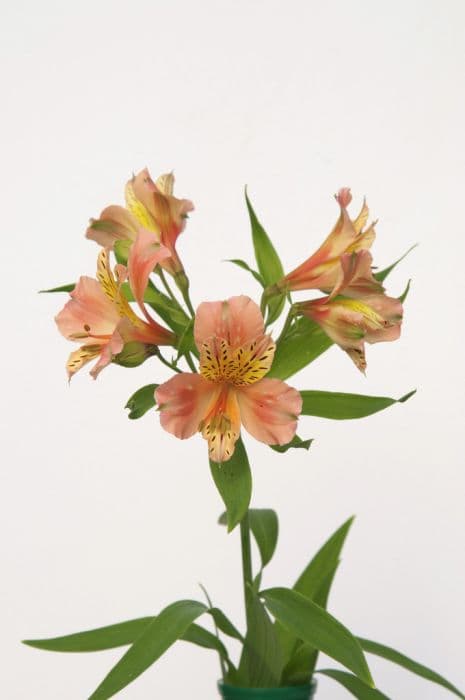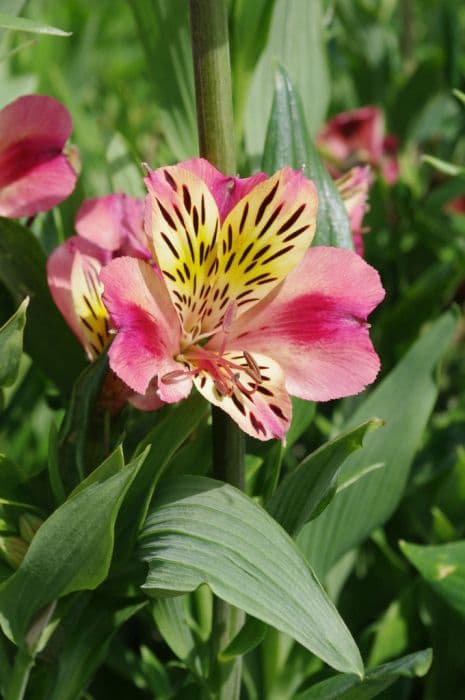Peruvian Lily Alstroemeria 'Candy'

ABOUT
Alstroemeria 'Candy', commonly known as the Peruvian Lily or Lily of the Incas, is a striking perennial plant that is appreciated for its vibrant and colorful appearance. Its flowers are the most distinctive feature, characterized by their unique shape and an array of hues. These blooms have a trumpet-like form, consisting of six petals that display a blend of colors, such as deep pink, rose, and white, with streaks or spots often in a contrasting shade, such as dark burgundy or yellow. Each individual flower exhibits a semblance of symmetry, and the petals sometimes bear a slight ruffling on the edges, adding a delicate touch to their appearance. The center of the flower is typically marked with darker streaks leading towards the throat, creating a focal point and adding depth to the flower’s visual appeal. The plant's foliage is also noteworthy, comprising lance-shaped leaves that are a lush green in color. The leaves are spirally arranged around the stem, creating a dense and bushy texture. Their surface is slightly glossy, which further contributes to the plant’s overall luster and vibrancy. Alstroemeria 'Candy' displays its blooms in clusters, with several flowers often atop a single tall, upright stem, giving the plant a very full and abundant feeling. This cluster of blooms forms a lovely bouquet-like display that can add a splash of color to gardens or floral arrangements.
About this plant
 Names
NamesFamily
Alstroemeriaceae
Synonyms
Peruvian Lily, Lily of the Incas, Parrot Lily
Common names
Alstroemeria 'Candy'.
 Toxicity
ToxicityTo humans
The Alstroemeria, commonly known as the Peruvian Lily or Lily of the Incas, has a low toxicity level to humans. Ingestion of this plant is typically not life-threatening but may cause mild gastrointestinal discomfort, including nausea, vomiting, and diarrhea. It is advised to avoid ingesting any part of the plant and to handle with care as the sap can cause skin irritation in sensitive individuals.
To pets
The Alstroemeria or Peruvian Lily has a mild to moderate toxicity level to cats and dogs. If ingested, it can cause symptoms such as vomiting, diarrhea, hypersalivation, and occasionally, irritation or inflammation of the mouth or throat. It is important to prevent pets from consuming parts of this plant to avoid these potential side effects.
 Characteristics
CharacteristicsLife cycle
Perennials
Foliage type
Deciduous
Color of leaves
Green
Flower color
Mixed
Height
2-3 feet (0.6-0.9 meters)
Spread
1-2 feet (0.3-0.6 meters)
Plant type
Bulb
Hardiness zones
7
Native area
South America
Benefits
 General Benefits
General Benefits- Long blooming period: Alstroemeria 'Candy' can bloom for several months, providing a long-lasting display of flowers.
- Attracts pollinators: The plant is known to attract bees, butterflies, and hummingbirds, supporting biodiversity.
- Low maintenance: Once established, Peruvian lilies require minimal care, making them ideal for gardeners of all levels.
- Vibrant colors: The flowers come in a range of bright and attractive colors, which can enhance the visual appeal of gardens and landscapes.
- Great for cut flowers: Peruvian lily blooms have a long vase life, making them perfect for floral arrangements and bouquets.
- Drought tolerant: Alstroemeria 'Candy' can tolerate periods of low water, which is beneficial in areas with water restrictions or dry climates.
- Versatile planting options: The plant can be used in borders, containers, or as a ground cover, offering flexibility in garden design.
 Medical Properties
Medical PropertiesThis plant is not used for medical purposes.
 Air-purifying Qualities
Air-purifying QualitiesThis plant is not specifically known for air purifying qualities.
 Other Uses
Other Uses- Photography subject: The vibrant and colorful blooms of Alstroemeria, also known as Peruvian lily, make it an excellent subject for photographers specializing in floral and botanical imagery.
- Eco-friendly confetti: Dried petals of the Peruvian lily can be used as a biodegradable confetti alternative at celebrations, reducing waste and environmental impact.
- Dye source: The petals of the Peruvian lily can be used to produce natural dyes for textiles, offering a range of hues for sustainable fabric coloring.
- Edible garnish: While not widely recognized as an edible flower, the petals of Peruvian lily can be used to garnish desserts and salads, bringing a splash of color to dishes.
- Artistic inspiration: Artists can use the striking patterns and colors of the Peruvian lily as inspiration for paintings, illustrations, and textile designs.
- Thematic decorations: Peruvian lilies can be incorporated into event decorations for Peruvian-themed parties or cultural events to add authenticity and floral beauty.
- Floral crafts: The sturdy stems and long-lasting flowers of the Peruvian lily make them ideal for creating floral crowns, wreaths, and other craft projects.
- Bookmarks: Pressed flowers of the Peruvian lily can be laminated or placed in clear sleeves to create unique and natural bookmarks.
- Teaching tool: Botany educators can use the Peruvian lily to demonstrate various plant structures, such as leaves, stems, and bilateral symmetry in flowers.
- Candle decoration: The petals of the Peruvian lily can be embedded into the wax of handmade candles to add a decorative and unique touch.
Interesting Facts
 Feng Shui
Feng ShuiThe Peruvian Lily is not used in Feng Shui practice.
 Zodiac Sign Compitability
Zodiac Sign CompitabilityThe Peruvian Lily is not used in astrology practice.
 Plant Symbolism
Plant Symbolism- Friendship - Alstroemeria, commonly known as Peruvian Lily, often symbolizes strong and enduring friendships because of its twisted leaves which represent the intertwining of friends.
- Devotion - The Peruvian Lily signifies devotion and mutual support between people, highlighting the lasting bonds between friends or lovers.
- Prosperity - With its wealth of colorful blooms, the Peruvian Lily is frequently associated with prosperity and abundance in one's life.
- Achievement - The vibrant multiple flowers of the Peruvian Lily can symbolize achievement and the celebration of successes, making it a good gift for congratulations.
- Fortitude - Due to its hardiness and ability to adapt to different environments, the Peruvian Lily represents strength and resilience through life's challenges.
 Water
WaterPeruvian Lily requires consistent moisture, so water whenever the top inch of soil feels dry to the touch. Typically, this will be once or twice a week, depending on climate and soil drainage. Provide about 1 gallon of water for outdoor plants to ensure moisture reaches deep roots. During very hot or windy weather, you may need to water more often to prevent the soil from drying out completely. In cooler weather or if the plant is indoors, reduce watering frequency to avoid waterlogged soil.
 Light
LightThe Peruvian Lily thrives in bright, indirect light or partial shade. It should be placed in a location where it receives filtered sunlight for most of the day; direct afternoon sun may be too intense and could scorch the leaves. An east-facing or north-facing window is ideal for indoor plants, while outdoor plants benefit from morning sunlight and afternoon shade.
 Temperature
TemperatureThe Peruvian Lily prefers temperatures between 65-80°F for optimal growth. It can tolerate a minimum of 40°F, but frost can be damaging, so provide protection or bring indoors if temperatures are expected to drop. This plant does not thrive in extreme heat, so keep it away from full sun and hot temperatures above 90°F.
 Pruning
PruningThe Peruvian Lily benefits from deadheading to encourage further blooming and maintain a tidy appearance. Cut back spent flower stems and remove any dead or yellowing leaves as needed. After the blooming season in late summer or fall, prune the plant back to the ground to help rejuvenate it for the next season.
 Cleaning
CleaningAs needed
 Soil
SoilPeruvian Lily (Alstroemeria 'Candy') thrives best in fertile, well-draining soil with a pH of around 6.0 to 7.0. A mix of two parts loam, one part sand or perlite, and one part peat or humus would create an ideal environment for its roots. Regular enrichment with organic compost will benefit the plant's growth and flower production.
 Repotting
RepottingPeruvian Lilies should be repotted every 2 to 3 years to refresh the soil and accommodate root growth. Overcrowded tubers can be divided during repotting to propagate new plants and prevent excessive clumping.
 Humidity & Misting
Humidity & MistingPeruvian Lily prefers moderate humidity levels, typically between 40% to 60%. Avoid environments that are too dry, as these can lead to stress and reduced flowering. Misting or a pebble tray can help maintain optimal humidity.
 Suitable locations
Suitable locationsIndoor
Place in bright, indirect light and keep moist.
Outdoor
Plant in partial shade and protect from strong winds.
Hardiness zone
7-10 USDA
 Life cycle
Life cycleThe Peruvian Lily 'Candy', typically starts its life cycle when its seeds are planted in fertile, well-drained soil in late spring to early summer after the danger of frost has passed. Upon germination, the plant begins its vegetative growth stage, developing roots, shoots, and leaves to harness sunlight and nutrients. Following the vegetative stage, the Peruvian Lily enters the flowering phase, usually in the early summer, where it produces showy, colorful flowers that can last for several weeks. After pollination, which can be facilitated by insects, the plant may produce capsules containing seeds, thus completing its reproduction phase. Once mature, it enters a period of dormancy in the autumn and winter months, where growth slows down and above-ground parts may die back, though the tuberous roots remain alive underground. With the return of favorable conditions in the following spring, the Peruvian Lily 'Candy' resumes growth, completing its annual life cycle.
 Propogation
PropogationPropogation time
Spring-Early Summer
The Alstroemeria 'Candy', commonly known as Peruvian Lily or Lily of the Incas, is generally propagated by division, which is the most popular method for this plant. It is best done in the spring, when the plant emerges from dormancy and the new growth begins. To propagate by division, carefully lift the clump of tubers from the ground using a fork or shovel. Gently separate smaller clumps from the main mass, ensuring that each division has at least one or two shoots and a portion of tuber. Replant the divisions at the same depth they were previously growing, approximately 6-8 inches (15-20 centimeters) apart, to allow for adequate space for the roots to establish. Water the new plants thoroughly after planting, which will help to settle the soil around the tubers and roots, and to encourage new growth.



![Peruvian lily [H.R.H. Princess Alice]](/_next/image?url=https%3A%2F%2Fplants-admin.emdemapps.com%2Fimages%2Fplants%2F%2Fimages%2F604b55e81c8b0.png&w=640&q=75)
![Peruvian lily [Indian summer]](/_next/image?url=https%3A%2F%2Fplants-admin.emdemapps.com%2Fimages%2Fplants%2F%2Fimages%2F604b616bc746b.png&w=640&q=75)
![Peruvian lily [Inticancha Creamy Dark Pink]](/_next/image?url=https%3A%2F%2Fplants-admin.emdemapps.com%2Fimages%2Fplants%2F%2Fimages%2F604b5e98bea7c.png&w=640&q=75)
![Peruvian lily [Inticancha Dark Purple]](/_next/image?url=https%3A%2F%2Fplants-admin.emdemapps.com%2Fimages%2Fplants%2F%2Fimages%2F604b5381bb78f.png&w=640&q=75)
![Peruvian lily [Inticancha Imala]](/_next/image?url=https%3A%2F%2Fplants-admin.emdemapps.com%2Fimages%2Fplants%2F%2Fimages%2F604b619b522ba.png&w=640&q=75)
![Peruvian lily [Inticancha Red]](/_next/image?url=https%3A%2F%2Fplants-admin.emdemapps.com%2Fimages%2Fplants%2F%2Fimages%2F604b5aebac273.png&w=640&q=75)
![Peruvian lily [Inticancha Sunday]](/_next/image?url=https%3A%2F%2Fplants-admin.emdemapps.com%2Fimages%2Fplants%2F%2Fimages%2F604b646146dd9.png&w=640&q=75)